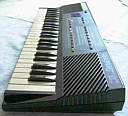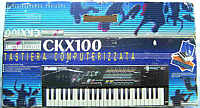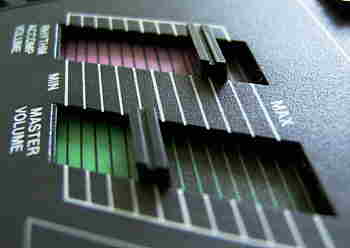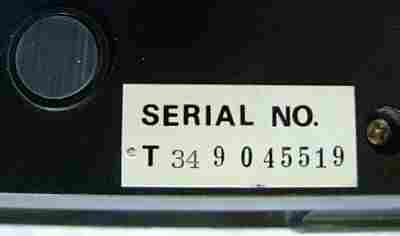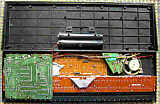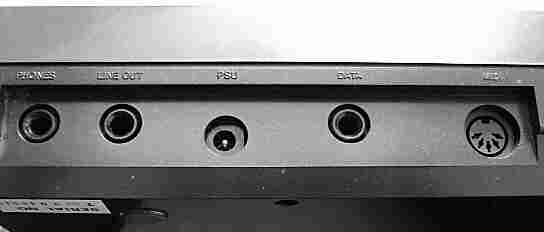 |
![PLAYRIGHT mode, Computer Aided Harmony [CAH]](picts/Amstrad_CKX100_playright.jpeg) digital
keyboard with lovely pop organ sounds, great demos & MIDI digital
keyboard with lovely pop organ sounds, great demos & MIDI |
|
This keyboard is a historical oddity, because although it was released
in 1988 (box copyright date), its sound and case style, box design and
especially the long and lovely demos resemble much more the early digital
sound estheticism from around 1984. The main voice is made from very clean
digital dual waveform timbres those imitate FM and resemble very much the
great Yamaha MK-100 from 1983,
and like the latter it has even a trio mode ("auto harmony") for cheesy
pop organ chords.
An unusual special feature of this instrument is the "playright mode",
which switches the right keyboard section to pentatonic tone scales, those
vary with the actual chord (selected with the left hand) to force the player
to play what establishment considers harmonious (a bit like an Omnichord).
The cheesy single finger accompaniments are quite over- orchestrated and
thus less versatile. The percussion is made from simple low resolution
samples and resembles much
Bontempi GT
759. There is also a MIDI- out jack and a simple sequencer with
data storage on audio cassettes. The preset sound and rhythm selection
is a bit awkward, since you have to press buttons multiple times to step
through them, and the demos appear between the rhythms. Initially the PCB
stank badly of epoxy.
The Amstrad Fidelity CKX100 seems to be extremely rare and likely
was only released in Spain (I bough mine from eBay), since the manual,
box and warranty card is in Spanish and I neither saw the CKX100
nor any other Amstrad keyboards elsewhere yet. The company Amstrad
was known in 1980th for cheap and often poor sounding stereo sets and the
famous Amstrad CPC 464/ 664/ 6128 home computer series. In Germany
their HiFi and computer stuff was sold under the Schneider brand.
main features:
-
49 midsize keys
-
2 built-in speakers (sound bright and fairly bassless, stereo)
-
main voice polyphony 8 notes (only 3 with accompaniment, 1 in trio mode)
-
10 semi- OBS preset sounds {elec piano, synth 1, guitar, flute, bells |
brass, synth 2, harpso, organ, strings}
-
28 preset rhythms {r & b, hi-tec, pop, swing 1, dixie, samba, march
1 | rock 1, disco, funk, swing 2, hoedown, salsa, march 2 | rock 2, reggae
1, hip-hop, bounce, country, bossa, waltz 1 | boogie, reggae 2, heavy metal,
ballad, barock, pop-cha, waltz 2} (selected in a sequence by 7 group +
1 select button)
-
volume & separate rhythm accomp volume slider
-
vibrato & sustain button
-
trio mode ("auto harmony" button)
-
single finger accompaniment (manual chord mode with rhythm off)
-
"playright" mode (switches keyboard to pentatonic scales selected by the
current single finger chord)
-
tempo +/- buttons (21 steps)
-
rhythm fill-in button
-
keyboard drum kit mode only during demos {whistle, hand clap, dog, cowbell,
bell} (each 3 pitches)
-
many orange, green & yellow LEDs
-
main voice sound is based on 2 layered static digital waveforms with independent
simple envelope; with some low tones mild sample aliasing noise gets audible.
The sound is stereo; the 3rd keyboard octave is panned to the center, lower
notes only to the left channel and higher notes only to the right. Percussion
is made from thin sounding low resolution samples.
-
complex multi- chip hardware (crystal clocked):
-
CPU= "8J2, HD63B03XP, Japan" (64 pin DIL)
-
IC8 (sound IC)= "ST, M114S, 28832" (40 pin DIL)
-
IC5 (RAM?)= "KM6264AL-10, 844, Korea" (28 pin DIL)
-
IC4 (EPROM) ="VER. 2.22 4D37" (28 pin DIL)
-
IC7 (EPROM) ="VER. 11.5 19R7" (28 pin DIL)
-
IC9 "KIA7769P, 8L" (16 pin DIL)
-
8 KByte RAM, 48 KByte ROM
-
simple sequencer (polyphonic record/ playback with accompaniment, no edit)
-
7 long and complex orchestrated demo melodies (those mute their main voice
during manual play)
-
jacks for AC- adapter, phones, line out, tape data saving, MIDI out
-
demo audio cassette
modifications:
-
AC- adapter jack polarity changed to standard, polarity protection diode
added.
notes:
The Amstrad Fidelity CKX100 is a great authentic piece of mids 1980th
sound and design estheticism, that was already a bit anachronistic when
it came out in 1988. Especially the demos sound like cheesy digital synth
muzak from around 1984, and the control panel looks like a mixture of Yamaha
DX7 and late 1980th ghettoblasters; e.g. the background of the volume
sliders moves with the slider, and the type labels include in a stylish
1970th font the writing "computerphonic". Also the rastered pictures on
the box and manual look rather like from beginning of 1980th. Unfortunately
the internal program is stored on EPROMs, those are infamous to loose their
data over time by bitrot. (But I hope that these late 1980th ICs are more
reliable than the first generation EPROMs, those are well hated in early
arcade videogames and pinball machines for spontaneous dying.) The preset
rhythms are awkwardly selected in a row- column manner; while the row is
selected by 7 individual group buttons, the columns can be only stepped
through with a single "rhythm select" button; the 1st column even contains
the 7 demo musics, those are selected and started like rhythms. When I
bought this instrument, the "tempo up" button didn't work by a faulty keyboard
matrix diode.
The main voice sound is made from 2 layered static digital waveforms
with independent simple envelopes. All preset sounds are quite bright,
but (unlike e.g. My Music Center)
don't sound rough by DAC frequency aliasing noise or the like, but have
a pure and clean high quality synth appeal. The sound style resembles mostly
the Yamaha MK-100 sound generator,
that was designed to imitate simple FM timbre sweeps by crossfading between
2 waveforms. Like with genuine FM instruments, the timbres are time- dynamically
playable, i.e. the timbre and especially the volume of the release phase
changes with the key press duration. But the CKX100 timbres have
also many similarities with Casio's early consonant- vowel synthesis
instruments (especially Casio MT-30),
although the latter had only squarewave muffled by low- pass filters, while
the CKX100 uses dull waveforms instead of filters and thus has not problems
with quieter sounding high notes. But it still can do the characteristic
buzzy "enng!" sound in the bass range in some timbres. The "elec piano"
is very bright with a slightly scratchy, percussive attack phase. The "synth
1" resembles a grainy, brassy guitar (or banjo?) sound that fades thinner.
The "guitar" begins duller and has a too soft attack phase. The "flute"
sounds quite dull with some zipper noise in the attack phase; it resembles
more a wooden pipe organ rank. The "bell" resembles a vibraphone without
vibrato and with a slightly knocking attack phase. "brass" is a grainy
synth- tuba with a scratchy dose of zipper noise in the attack phase, which
sounds like archaic Casio consonant- vowel stuff or a C64 SID sound. "synth
2" is a bright and thin timbre that goes "enng!" during attack, holds the
note like an organ and has a short sustain. Also the "harpso" sounds thin
and bright and has a too slow attack phase for a picked string. The "organ"
is a plain, but nicely made Hammond organ timbre with mild percussive
attack phase. The "string" sounds more like a saxophone and is likely made
from a sawtooth wave; its 3rd and 4th keyboard octave play too quiet, which
seems to be no filter problem but a badly programmed stereo panning (or
a faulty right loudspeaker?). The sustain button adds to all preset sounds
a quite long sustain (3 to 4 seconds), while the vibrato button adds a
7Hz vibrato. (The preset sounds contain no own vibrato when off.) These
buttons also affect held notes, while the preset sound buttons only change
the timbre of later pressed keys.
Scott Nordlund e-mailed
me the following info about the main voice sound chip: (edited by me)
About the Amstrad CKX100, I was very interested to see
that the soundchip is an M114S. I have a very rare and obscure Italian
synthesizer, the Keytek CTS-2000 (Keytek previously was known
as Seil and made shitty string ensembles and self-destructing synths),
that uses two of these (along with CEM 3389 VCF/VCA chips). I wrote about
it here if you're interested in more info: http://www.geocities.com/diffused_light/stuff/cts2000.html
The M114S chip is made specifically for crossfading waveforms (like
a more advanced version of Casio's Consonant-Vowel synthesis) but
evidently it didn't get a lot of use. Actually, because of the page I made,
someone emailed me asking for information on that chip, because it was
used in some obscure arcade game and he was trying to find out how it worked
so it could be emulated for MAME. He said he had hit a total dead end trying
to find out about it and that I was the only person who had even replied
to his request (though unfortunately I didn't have any information and
had similarly failed to turn up anything). I told him to drop me a line
if he ever found anything but I haven't heard back.
...
This synth actually used a very unique method of sound generation.
Rather than store full samples, there were instead single-cycle waveforms
sampled from the attack, decay, and sustain portions of whatever instruments
it was attempting to recreate. Each oscillator (2 oscillators per voice,
8 voices) is assigned 3 waveforms (probably 8 bit), and simple envelopes
crossfade between them. What's interesting about this is that the waveforms
can be arbitrarily used in any order. In theory this is more sophisticated
than what Roland did in the D50 (short sampled attack transients
and single-cycle waveforms for the sustain portion), but unfortunately
the sound is rather poor and the user interface is really terrible, it's
not surprising that no one bought them. Anyway I was just interested to
see that the same chip was used in something else, maybe the CKX100 uses
similar crossfading.
> Sounds like a very rudimentary wavetable sound synthesis (ask a search
engine about "Waldorf Wave" or "Waldorf Microwave" to see
what I mean).
Yeah, it is kinda, or like the Prophet VS, but none of those
synths can completely replicate the functionality. Possibly it was inspired
by the Synclavier's resynthesis functions: I read that the Synclavier
can perform an FFT of a sample, then the user can pick several points on
the resulting spectral display, and the sound will be played back on the
FM voices by interpolating between these points (called "timbre windows"
I think). Clearly this is what the designers had in mind, to cheaply resynthesize
instrument sounds instead of storing entire samples.
Conceptually this is great, especially to crossfade together vibraphone
waveforms with vocal waveforms, etc. Anyway the sound of the CTS-2000 means
that it's not very useful. Even the raw saw/square waveforms sound somehow
really bad, I'm not sure if it's the waveforms themselves that sound bad,
or the M114S chips, or some poorly-designed analog circuitry, but it's
just unpleasant to listen to.
|
The percussion of the rhythms is made from thin and unspectacular sounding
low resolution samples of acoustic drum kit stuff and some synth toms.
Unfortunately the rhythm plays too quiet in relation to the accompaniment,
which makes it badly audible. The accompaniments sound quite thin and cheesy,
but most are severely over- orchestrated and thus not really versatile.
Generally their timbre reminds much to FM soundcard game music on old PCs.
The styles are mainly mellow pop, disco and jazz stuff and have little
to do with their names; e.g. "hip-hop" is rather a fusion pattern, while
"heavy metal" is more a harmonious pop pattern. Some patterns remind to
the game "Sonic the Hedgehog" on Sega Megadrive/ Genesis. There
are also a few country patterns. By the lack of a fingered chord mode,
only a few different establishment chords can be played, but at least it
responds nicely fast to break up the monotony. The "fill-in" button mutes
the accompaniment during the fill-in pattern. Annoying is that selecting
a preset rhythm always switches the tempo back default value.
With rhythm off, the single finger chord mode plays chords in
a fixed brass timbre, which sounds fairly bright and a bit thin. Due to
the slow attack phase of the brass sound, the chord is muted for a short
time while changing the chord key, which can be used as a sound effect
to chop the chord pad. In single finger chord mode the "auto harmony" button
turns the main voice into a trio while a chord is played in the left keyboard
section. The additional 2 voices can be also trilled (while holding the
main voice note) by trilling the chord key. But during rhythm chords (of
the accompaniment) are held automatically (known as "chord memory" on other
instruments) and thus also the trio sound can not be trilled here.
An unusual special feature of this instrument is the "playright mode",
which switches the right keyboard section to pentatonic tone scales, those
vary with the actual chord (selected with the left hand) to force the player
to play what establishment academics considers harmonious. This concept
resembles much the strange "GLING" stuff on the Philips PMC100 portable
sequencer or the behaviour of a Suzuki Omnichord.
This instrument has 7 nicely arranged demos, those play quite long and
then repeat in a loop. According to the manual they are:
-
In the mood
-
Bread and butter
-
Variazione su brani di Mozart
-
Blue suede shoes
-
I can't give you anything
-
Pub singalong [Medley: "Oh When the Saints Go Marching In" followed by
various classic dixieland country stuff]
-
Money money money
The demos are selected like rhythms, basically like a 0th preset rhythm
column that is active by default. The 4th demo "Blue Suede Shoes" is a
rock 'n' roll that contains a guitar solo with a lot a bizarre gritty pitchbend
effects (rather glissando than portamento), those remind to Rob Hubbard's
famous e-guitar imitations in C64 SID musics. During demos you can also
switch the main voice preset sound, which is nothing uncommon but sounds
particularly good here.  Very
unusual is that only during demos (and nowhere else) the chord section
of the keyboard switches to a drum kit mode with 6 sound samples those
have the icons {whistle, hand clap, dog, cowbell, bell} and repeat in 3
different pitches. The "hand clap" sounds quite dull. The "dog" resembles
more a cuica or someone saying "huh" while the cowbell resembles a plop
noise (like pulling a cork out of a bottle) and the "bell" is the genuine
cowbell. As a play training feature you can also improvise to the accompaniment
of the demos, which automatically mutes their main voice and enables the
"playright mode".
Very
unusual is that only during demos (and nowhere else) the chord section
of the keyboard switches to a drum kit mode with 6 sound samples those
have the icons {whistle, hand clap, dog, cowbell, bell} and repeat in 3
different pitches. The "hand clap" sounds quite dull. The "dog" resembles
more a cuica or someone saying "huh" while the cowbell resembles a plop
noise (like pulling a cork out of a bottle) and the "bell" is the genuine
cowbell. As a play training feature you can also improvise to the accompaniment
of the demos, which automatically mutes their main voice and enables the
"playright mode".
There is also a sequencer that can save data on audio cassettes. But
I haven't fully examined it yet since my specimen came only with a Spanish
language manual. The sequencer is controlled through the rhythm and accompaniment
buttons, using the "fill/ ending" button for shift. It seems to have no
edit mode but at least records the polyphonic main voice with accompaniment
and preset sound & rhythm changes. But apparently it can not be used
without rhythm. Apparently also the 7th demo can be replaced by the sequencer
contents (or data loaded from cassette?), but I haven't figured out this
yet.
| removal
of these screws voids warranty... |
|
|
 |

|
|
| |
back
|
|

